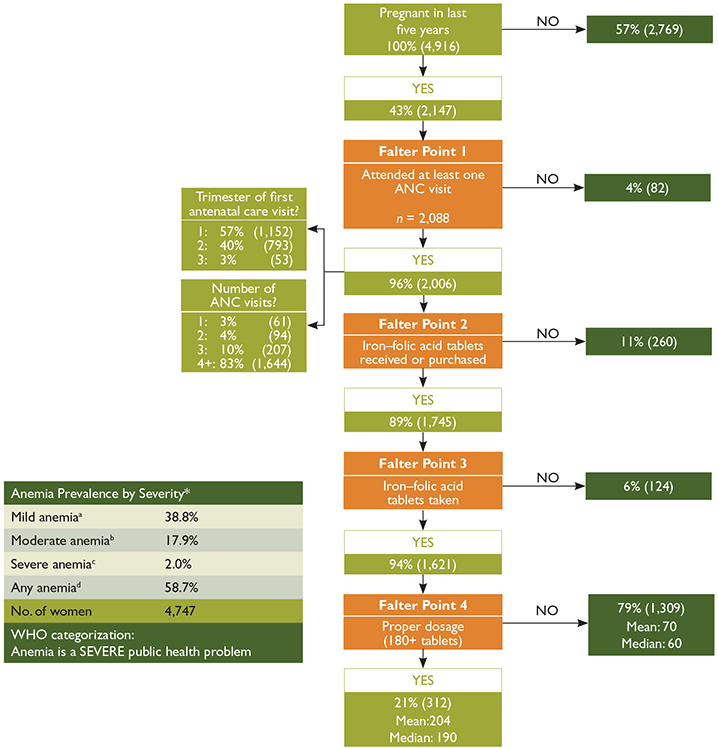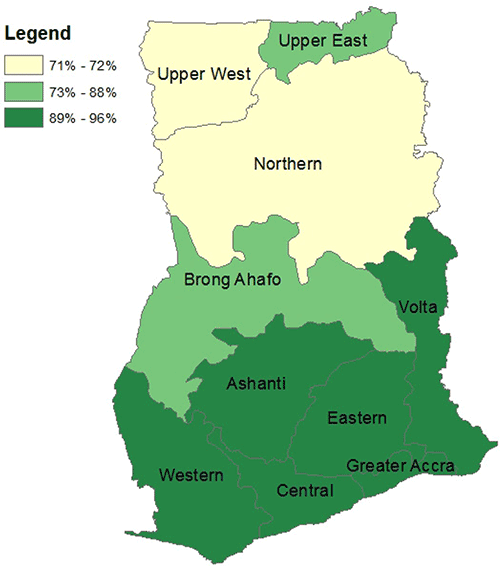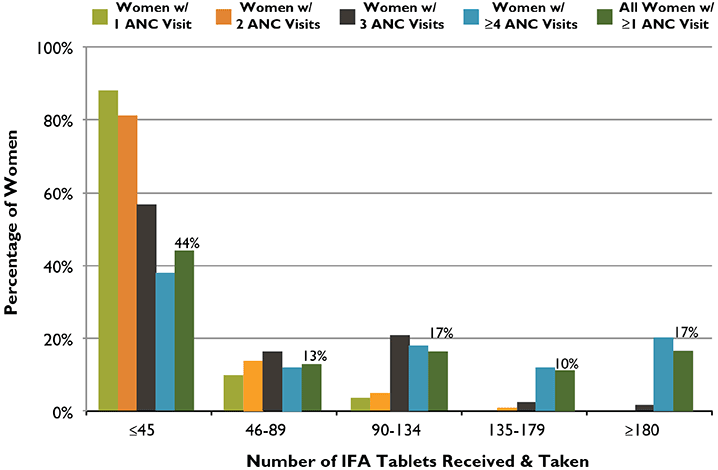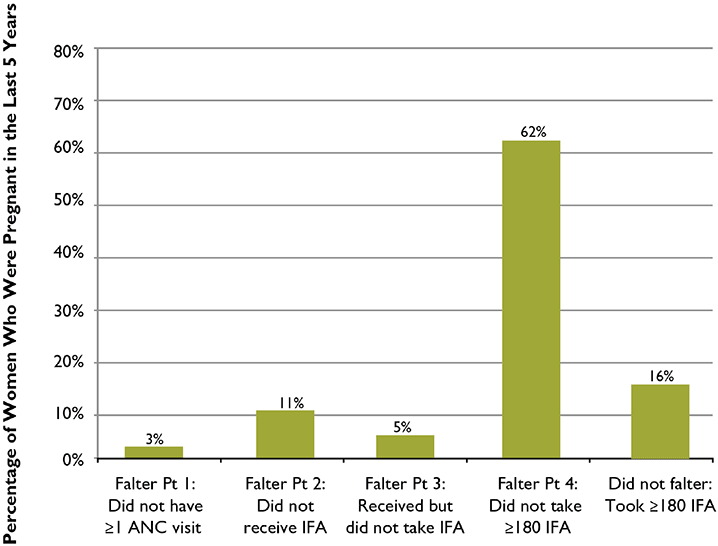Overview of the Global Anemia Problem, Including Iron Deficiency Anemia
The World Health Organization (WHO) defines anemia among women of childbearing age as the condition of having a hemoglobin concentration of < 12.0 g/dL at sea level; among pregnant women it is defined as < 11.0 g/dL. The hemoglobin concentration cutoff level that defines anemia varies by age, gender, physiological status, smoking status, and the altitude at which the assessed population lives.
The primary cause of anemia is iron deficiency, a condition caused by inadequate intake or low absorption of iron, the increased demands of repeated pregnancies—particularly if not well spaced (e.g., fewer than 36 months between pregnancies)—and loss of iron through menstruation. Other causes of anemia include vitamin deficiencies (such as a deficiency of folic acid or vitamin A), genetic disorders, malaria, parasitic infections, HIV, tuberculosis, common infections, and other inflammatory conditions. While iron deficiency anemia (IDA) accounts for about one-half of all anemia cases, it often coexists with these other causes.
Iron deficiency anemia is most common during pregnancy and in infancy, when physiological iron requirements are the highest and the amount of iron absorbed from the diet is not sufficient to meet many individuals’ requirements (Stoltzfus and Dreyfuss 1998). Anemia’s effects include increased risk of premature delivery, increased risk of maternal and child mortality, negative impacts on the cognitive and physical development of children, and reduced physical stamina and productivity of people of all ages (Horton and Ross 2003). Globally, IDA annually contributes to over 100,000 maternal deaths (22 percent of all maternal deaths) and over 600,000 perinatal deaths (Stoltzfus, Mullany, and Black 2004). Key anemia control interventions include promoting a diversified diet, iron-folic acid (IFA) supplementation during pregnancy, iron fortification of staple foods, prevention and treatment of malaria, use of insecticide-treated bed nets, helminth prevention and control, delayed cord clamping, and increased birth spacing.
Maternal Anemia in Ghana
The prevalence of anemia among pregnant women in Ghana is 70 percent, making it a severe public health problem as defined by WHO standards1 (GSS, GHS, and ICF Macro 2009). In terms of anemia severity, the majority of cases among pregnant and breastfeeding or non-pregnant women reported in the 2008 Ghana Demographic and Health Survey (GDHS) are classified as mild or moderate.2 Roughly seven percent of anemia cases in pregnant women and two percent of cases in breastfeeding or non-pregnant women are diagnosed as severe. Various factors may contribute to the severity of anemia. A study conducted in rural Ghana found that multiple pregnancies, low body mass index, and having fewer than four antenatal care (ANC) visits were among the factors associated with severe anemia among pregnant women (Geelhoed et al, 2006).
Falter Points in Women's Consumption of Iron-Folic Acid During Pregnancy
WHO recommends that all pregnant women receive a standard dose of 30–60 mg iron and 400 μg folic acid beginning as soon as possible during gestation (WHO 2012). Ideally, women should receive iron-containing supplements no later than the first trimester of pregnancy, which means ideally taking 180 tablets before delivery. It is important to note, that many countries aim for women to receive 90 or more tablets during pregnancy.
Figure 1 shows a decision-tree analysis of how well the Ghanaian ANC system distributes IFA, and identifies four potential points at which the system might falter (highlighted in orange). The figure tracks the number and percentage of women who obtained ANC, those who subsequently received and consumed at least one IFA tablet, and those who consumed the ideal minimum number of tablets.3 All data are based on GDHS questions asked of women who were in permanent unions and had been pregnant in the five years prior to being interviewed4 (GDHS; GSS, GHS, and ICF Macro 2009).
Figure 1. Analysis of Falter Points Related to Distribution and Consumption of IFA through Ghana’s ANC Program in 2008, Women of Reproductive Age (15–49 Years) n = 4,916

Main Conclusions: Given the high coverage rate, ANC provides an outstanding platform for distributing IFA. Among women who were pregnant in the last five years, had at least one ANC visit, and took at least one IFA tablet, only 21 percent received and took the minimum ideal number of tablets. The most critical shortcoming is Falter Point 4; both supply and demand are likely constraints.
*Percentage of women 15–49 years based on Hemoglobin levels, Hb (g/dL)
aNPW 10.0≤Hb≤11.9, PW 10≤Hb≤10.9 b7.0≤Hb≤9.9, PW 7.0≤Hb≤9.9 cNPW Hb<7.0, PW Hb<7.0 dNPW Hb<12.0, PW Hb<11.0
Non-responses, no data (NR/ND) were recoded to “No” for “At least one ANC visit?”, “IFA tablets received?”, and “IFA tablets taken?” and to zero for “Number of tablets taken?”
Anemia prevalence data are provided as a reference point, signaling the general order of magnitude of the anemia public health problem. The ANC utilization data is based on self-reported data of women 15–49 years in permanent unions and pertains to their last pregnancy in the last five years prior to the DHS survey.
Source: Calculations and anemia levels are from the Ghana Demographic and Health Survey (2008).
Many supply-side aspects—including both adequacy of IFA tablet supplies and technical knowledge and practices of ANC providers—need to be considered when assessing how well an ANC program delivers IFA. In addition, as Falter Point 4 in Figure 1 clearly shows, the provision of IFA tablets to a pregnant woman is a necessary but not sufficient condition for the woman to consume the tablets, particularly at the ideal minimum level. Thus, demand-side factors also play a critical role in determining the coverage and effectiveness of a program. These include whether or not women seek ANC and the timing and number of visits, as well as the extent to which women are aware of the significance of anemia and IFA, ask for IFA tablets, and comply with the IFA regimen.
Understanding the relative significance of each falter point makes it possible to prioritize them for more in-depth analysis, providing a first step in an evidence- based approach to systematically improving the program. The DHS does not collect information on the number of IFA tablets received by women. In the case of Falter Point 4, this lack of data creates ambiguities that make it impossible to fully understand whether shortcomings of the system relate primarily to supply- or demand-side factors. Despite this limitation, the decision-tree analysis presented in Figure 1 still enables prioritizing the falter points for more in-depth analysis and action at the national, district, and health center levels.
Analysis of Falter Points
Falter Point 1:
Did not attend at least one ANC visit
Only four percent of women did not have at least one ANC visit.
ANC’s high coverage gives it great potential as a vehicle for providing IFA.
Falter Point 2:
Did not receive or purchase at least one IFA tablet
Of the women who had at least one ANC visit, 11 percent did not receive or purchase any IFA tablets.
This supply-side constraint may be due to various system/supply-side performance shortcomings, which could reflect: (1) inadequate supply (e.g., stockouts); (2) inadequate provider knowledge; or (3) inadequate provider practices, whereby IFA may not have been provided. As Figure 2 shows, this is the second-most important falter point among all pregnant women in Ghana.
Unfortunately, the GDHS does not report the source(s) of the IFA tablets women received or purchased, and a small percentage of women attending ANC get IFA tablets from a different source. While only three percent of Ghanaian women who received or purchased IFA did not have any ANC visits (not shown), we cannot ascertain whether or not those who received ANC obtained their IFA from their ANC provider. However, women who attend ANC may be more likely to be aware of, to value, and also to take IFA tablets, regardless of where they obtain them. Thus, we would expect a high correlation between the number of women who had at least one ANC visit and those who received or purchased IFA, which is consistent with the data. Women who have one or more ANC visits and who did not receive any IFA represent a missed opportunity to reduce the risk of anemia among a high-risk population.
Falter Point 3:
Did not take at least one IFA tablet
Of the women who received IFA, six percent did not consume any tablets.
This demand-side constraint is relatively small and may be due to women not understanding the significance of anemia and/or the significance of IFA. This misunderstanding may reflect: (1) inadequate provider counseling and follow-up; (2) women’s beliefs about actual or possible side effects; or (3) sociocultural factors.
Falter Point 4:
Did not consume 180 or more IFA tablets
Of the women who received and took IFA, 79 percent did not consume the ideal minimum of 180 IFA tablets.
This constraint results from a combination of supply- and/or demand-side factors. Figure 1 suggests possible contributing factors to this falter point: beginning ANC too late or after the first trimester, obtaining fewer than WHO’s recommended four ANC visits during pregnancy, or not having had enough ANC visits to receive 180 tablets (given IFA distribution protocols). Forty-three percent of women who received ANC began their care after the first trimester, and the 17 percent who had fewer than WHO’s recommended four ANC visits during their last pregnancy may have started their ANC too late or may not have had enough visits to receive 180 tablets (given IFA distribution protocols). Further research is needed to establish the relative importance of these contributing factors, as well as the significance of other possible causes.
Globally, research has found that the following situations often contribute to Falter Point 4: (1) providers do not have access to adequate supply; (2) women do not receive adequate tablets because they have little access to care, or start ANC late, or do not have enough ANC visits, making it difficult to obtain 180 tablets (given IFA distribution protocols); (3) providers do not provide adequate counseling or follow-up; (4) women do not adhere to the regimen, which may be due to difficulty in remembering to take the tablets daily, not knowing all the tablets are necessary, fear of having a big baby, side effects, or tablet-related issues (taste, size, color, coating, packaging/storage problem). Further research is needed to determine the underlying factors contributing to this falter point in Ghana.
Analysis by Sociodemographic Variables and Trends Over Time
A comparison of 2003 and 2008 GDHS data reveals that while the percentage of Ghanaian women who received ANC and IFA supplementation during their last pregnancy increased to 96 percent and 87 percent, respectively, the prevalence rate of anemia among pregnant women remains alarmingly high, at 70 percent, and among all women it is increasing. Table 1 provides a disaggregated look at the percentage changes in anemia, ANC coverage, and IFA coverage from 2003 to 2008. Several regions within the country have anemia rates above 60 percent among women aged 15–49 years, well above the prevalence rate at which WHO categorizes anemia as a severe public health problem. The national anemia prevalence rate increased 14 percentage points between 2003 and 2008. The two regions with the largest increases, Western and Central, both had slipping ANC coverage over this period.
Table 1. Changes in Anemia Prevalence and ANC and IFA coverage by Region, Residence Area, and Wealth in Ghana Among Women Aged 15–49 Years Who Had a Live Birth in the Last Five Years,* 2003 and 2008
| Characteristic | Anemia Prevalence | Change in Prevalence | ANC Coverage | Change in Prevalence | Took 1 + IFA Tablets | Change in Prevalence | |||
|---|---|---|---|---|---|---|---|---|---|
| 2003 | 2008 | 2003 | 2008 | 2003** | 2008 | ||||
| Region | |||||||||
| Residence | |||||||||
| Wealth | |||||||||
| Western | 39.1% | 71.2% | 32.1% | 96.3% | 95.8% | -0.6% | 77.1% | 92.2% | 15.1% |
| Central | 38.0% | 63.7% | 25.7% | 95.7% | 95.5% | -0.2% | 82.6% | 88.8% | 6.2% |
| Greater Accra | 47.0% | 50.7% | 3.7% | 96.7% | 97.7% | 1.0% | 82.2% | 93.9% | 11.7% |
| Volta | 48.5% | 58.1% | 9.6% | 90.5% | 91.2% | 0.7% | 84.4% | 90.4% | 6.0% |
| Eastern | 48.4% | 58.3% | 9.9% | 95.1% | 97.3% | 2.2% | 76.2% | 89.5% | 13.3% |
| Ashanti | 46.2% | 59.9% | 13.7% | 95.3% | 97.7% | 2.5% | 83.5% | 91.5% | 8.0% |
| Brong Ahafo | 33.5% | 57.8% | 24.3% | 97.3% | 97.7% | 0.4% | 91.4% | 84.5% | -6.9% |
| Northern | 49.8% | 59.3% | 9.5% | 83.5% | 96.9% | 13.4% | 65.2% | 69.3% | 4.1% |
| Upper East | 51.0% | 48.4% | -2.6% | 84.9% | 95.8% | 10.9% | 72.6% | 83.8% | 11.2% |
| Upper West | 49.7% | 66.9% | 17.2% | 91.6% | 96.6% | 5.0% | 59.0% | 69.2% | 10.2% |
| Urban | 41.6% | 55.3% | 13.7% | 98.2% | 98.3% | 0.1% | 85.1% | 89.9% | 4.8% |
| Rural | 47.6% | 61.8% | 14.2% | 90.2% | 95.1% | 5.0% | 75.7% | 84.2% | 8.5% |
| Lowest 40% | 49.7% | 61.9% | 12.2% | 88.5% | 94.4% | 5.9% | 73.3% | 81.1% | 7.8% |
| Highest 40% | 40.1% | 55.9% | 15.8% | 97.9% | 98.7% | 0.8% | 84.8% | 92.5% | 7.7% |
| National Average | 44.7% | 58.7% | 14.0% | 93.1% | 96.4% | 3.3% | 79.1% | 86.5% | 7.4% |
**The 2003 GDHS reports IFA coverage as the percentage of women with a live birth in the five years preceding the survey who received IFA tablets, but does not state whether or not the tablets were consumed.
As seen in Table 1, Ghana has also made progress in increasing ANC and IFA coverage, which, by international standards, are high. Between 2003 and 2008, ANC coverage nationwide grew by three percent, and IFA coverage grew by more than double that amount. ANC coverage improved most dramatically in the Northern and Upper East regions, by 13 percent and 11 percent, respectively. These regions are predominantly rural and outreach by community health workers through Ghana’s Community-Based Health and Planning Services initiative has aimed at improving access to skilled maternity care (GSS, GHS, and ICF Macro 2009). Likewise, ANC and IFA coverage improved more markedly for rural women than for their urban counterparts. Between 2003 and 2008, the rural IFA coverage rate increased by 8.5 percentage points, nearly twice the increase in urban areas, and contributed to narrowing the already-small gap between rural and urban areas, which stood at 84.2 percent and 89.9 percent, respectively, in 2008. In 2003, Ghana developed an integrated strategy for controlling anemia, which included strengthening the quality and coverage of ANC, and emphasizing IFA supplementation for pregnant women and lactating mothers (FAO 2009).
Figure 2. Percentage of Women Who Had at Least One ANC Visit and Received at Least One IFA Tablet by Region, Ghana, 2008

Table 2. Number and Timing of ANC Visits, Ghana, 2003 and 2008
| Indicator | 2003 | 2008 | Change in Coverage | Percentage Change |
|---|---|---|---|---|
| Number of ANC Visits | ||||
| Month of First Visit | ||||
| 0 | 6.3% | 3.5% | -2.8% | -44.4% |
| 1 | 4.0% | 2.8% | -1.2% | -30.0% |
| 2-3 | 16.7% | 13.3% | -3.4% | -20.4% |
| 4+ | 69.4% | 78.2% | 8.8% | 12.7% |
| Don't Know/No Data | 3.7% | 2.3% | -1.4% | -37.8% |
| No Antenatal Care | 6.3% | 3.5% | -2.8% | -44.4% |
| < 4 | 46.4% | 55.0% | 8.6% | 18.5% |
| 4-5 | 34.7% | 31.9% | -2.8% | -8.1% |
| 6-7 | 10.7% | 8.0% | -2.7% | -25.2% |
| 8+ | 1.2% | 1.1% | -0.1% | -8.3% |
| Don't Know/No Data | 0.7% | 0.6% | -0.1% | -14.3% |
While ANC coverage rates exceed 91 percent in all regions and by residence area and wealth, IFA coverage rates are lower and vary substantially more. The percentage of women taking IFA tablets ranges from a low of 69 percent in the Northern and Upper West regions to 94 percent in Greater Accra. The most marked difference in IFA coverage (the percentage of women, among all women who were pregnant in the past five years, who received and took at least one IFA tablet) is by wealth. ANC coverage varied by only 6.5 percentage points between the regions with the highest coverage rate and Volta, the region with the lowest reported coverage.
Analysis by Geographic Regions within the Country
The map in Figure 2 shows the variation by region in the percentage of women with at least one ANC visit who received at least one IFA tablet. Through the ANC system, IFA coverage is high compared with other low- and middle-income countries (LMICs). Small variations in coverage exist between regions; however, higher coverage is seen in southern regions of the country, while the northern regions, with the exception of Upper East, have the lowest rates. The Upper West and Northern regions warrant targeting efforts to improve the coverage of IFA through ANC.
Analysis by Number of ANC Visits
Table 2 highlights the progress that Ghana has made in two key ANC indicators: the number of ANC visits and the timing of the first visit. Over the five year period between 2003 and 2008, more women obtained their first ANC visit within their first trimester of pregnancy and the percentage of women who had four or more ANC visits increased by 13 percent. Continued improvement of the percentage of women receiving ANC early in pregnancy has the potential to increase the number of women taking the ideal minimum of 180 IFA tablets (addressing Falter Point 4) and reduce the nationwide prevalence of anemia.
Figure 3. ANC Distribution of IFA Tablets: Number of Tablets Received and Taken According to Number of ANC Visits, Ghana, 2008

Figure 3 shows the relationship between the number of IFA tablets taken by women who had at least one ANC visit, and the number of ANC visits they had during their last pregnancy. Forty-four percent of women who had at least one ANC visit took at most one-quarter (45) of the ideal minimum number of IFA tabets. While women with more visits were generally likely to receive and take more IFA tablets, only 20 percent of women who had four or more ANC visits received the ideal minimum number of IFA tablets. Learning what accounts for this ceiling is a critical challenge to improving the effectiveness of ANC-based distribution of IFA in Ghana.
Overall Conclusions and Recommendations
Figure 4 presents the obstacles among all women, including those who did not receive ANC during their pregnancy, to taking the minimum ideal number of IFA tablets. In Ghana, Falter Points 2 and 4 are the greatest barriers. Improving the delivery of IFA supplementation in the country will therefore rely heavily on identifying and addressing program gaps in IFA supply management and health workers’ practices. Modifying some women’s long-term adherence behaviors, and addressing other points mentioned above, under “Analysis of Falter Points,” may also lead to more women taking a minimum of 180 tablets (addressing Falter Point 4).
In terms of both the timing of the initiation of ANC and the average number of visits obtained, Ghana shows greater success than other LMICs in this analysis. Eighty-four percent of women in Ghana attended four or more ANC visits in 2008, paving the way for increased IFA coverage in conjunction with improvements in maternal health. Receiving quality ANC is also essential to achieving Millennium Development Goal (MDG) 5: to reduce maternal mortality and improve maternal health. Ghana’s maternal mortality rate (MMR) in 2008 stood at 451 maternal deaths per 100,000 live births, one of the highest in the world. Significant improvements must be made if the country is to meet its MMR target of 185 in 2015 (NDPC and UNDP 2010). As this rapid assessment of the distribution of IFA tablets through ANC suggests, despite high ANC and IFA coverage rates, there is substantial room for improving both the supply and the demand sides of the country’s ANC program. Focusing on Falter Point 4 and improving IFA coverage and compliance to a minimum 180-tablet regimen is one way in which Ghana may achieve its MDG 5 targets in 2015. Improving the distribution of IFA through the ANC program is an important strategy for preventing and controlling anemia in Ghana, and for improving the nutrition and health status as well as the mental and physical capacity of women of reproductive age.
Figure 4. Relative Importance of Each of the Falter Points in Ghana: Why Women Who Were Pregnant in the Last Five Years Failed to Take the Ideal Minimum of 180 IFA Tablets

Note: Due to rounding and missing values, data may not sum to 100 percent.
Footnotes
1 WHO categorizes the severity of anemia as a public health problem according to the condition’s prevalence: < 5 percent, no public health problem; 5–19.9 percent, mild; 20–39.9 percent, moderate; ≥ 40 percent, severe.
2 The DHS hemoglobin levels used to diagnose the severity of anemia in non-pregnant women differ from those specified by WHO. The DHS cutoffs for pregnant (P) and non-pregnant (NP) women in hemoglobin g/ dL are mild, 10.0–10.9 (P), 10.0–11.9 (NP); moderate, 7.0–9.9 (P), 7.0–9.9 (NP); severe, < 7.0 (P), < 7.0 (NP); any, < 11.0 (P), < 12.0 (NP).
3 The GDHS asked about IFA tablets or capsules; this brief refers to all forms as “tablets.”
4 The GDHS provides a population-based, nationally representative sample of all women in Ghana.
References
Food and Agriculture Organization of the United Nations (FAO). 2009. Ghana Nutrition Profile. New York: FAO.
Geelhoed, D., F. Agadzi, L. Visser, E. Abldordeppey, K. Asare, P. O’Rourke, J. S. van Leeuwen, and J. van Roosmalen. 2006. “Severe Anemia in Pregnancy in Rural Ghana: A Case-control Study of Causes and Management.” Acta Obstetricia et Gynecologica Scandinavica 85(10):1165–71.
Ghana Health Service (GHS). 2003. National Reproductive Health Service Policy and Standards. 2nd ed. Accra: National Reproductive Health Service and Standards and GHS.
Ghana Statistical Service (GSS), Noguchi Memorial Institute for Medical Research (NMIMR), and ORC Macro. 2004. Ghana Demographic and Health Survey 2003. Calverton, MD: GSS, NMIMR, and ORC Macro.
Ghana Statistical Service (GSS), Ghana Health Service (GHS), and ICF Macro. 2009. Ghana Demographic and Health Survey 2008. Accra: GSS, GHS, and ICF Macro.
Horton, S., and J.Ross. 2003. “The Economics of Iron Deficiency.” Food Policy 28(1):51–75.
National Development Planning Commission (NDPC) and United Nations Development Programme (UNDP). 2010. 2008 Ghana Millennium Development Goals Report. Accra: NDPC and UNDP.
Stoltzfus, R. J., L. Mullany, and R. E. Black. 2004. “Iron Deficiency Anemia.” In Comparative Quantification of Health Risks: Global and Regional Burden of Disease Attributable to Selected Major Risk Factors. M. Ezzati, A. D. Lopez, A. Rodgers, and C. J. L. Murray, eds. Geneva: World Health Organization.
Stoltzfus, R. J., and M. L. Dreyfuss. 1998. Guidelines for the Use of Iron Supplements to Prevent and Treat Iron Deficiency Anemia. Washington DC: ILSI Press.
World Health Organization (WHO). 2012. “Guideline: Daily Iron and Folic Acid Supplementation in Pregnant Women.” Geneva: WHO.